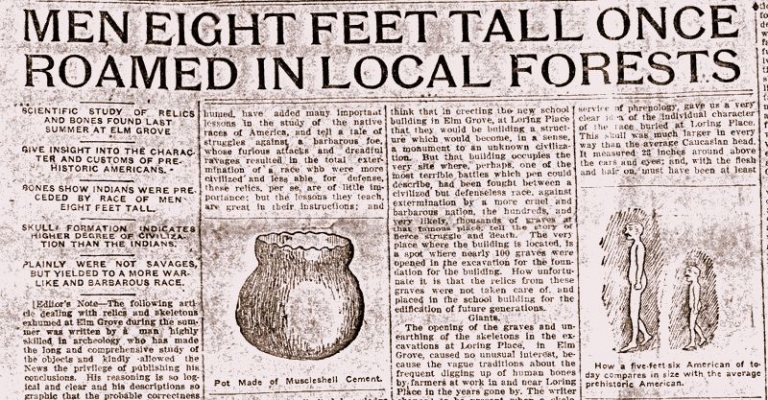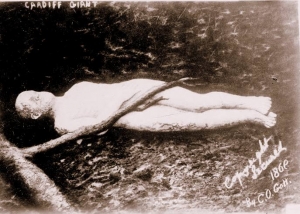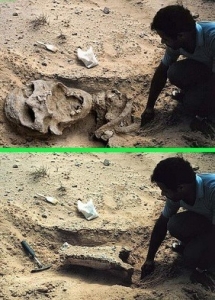
MOUNDSVILLE, W.Va. — After learning about my series of articles on West Virginia prehistory in West Virginia Explorer Magazine, Olivia Jones, an adjunct anthropology instructor who recently joined the museum's archaeological staff, suggested that we work together to address common misconceptions about "giant" Native Americans interred in West Virginia’s burial mounds.
What is the “giant” myth?
“The so-called giants in West Virginia are a prevailing myth that the Adena people were a race of giant prehistoric humans based on accounts of large skeletons found during West Virginian mound excavations,” Jones says.
She clarified that the giants being described in the myth aren’t supernatural in size. They are described as unusually tall individuals who would now be diagnosed with gigantism or acromegaly. Both are rare hormonal disorders. Acromegaly stimulates bone growth in the hands, feet, and face, and gigantism may cause individuals to grow more than seven feet tall.
Although instances of these conditions among prehistoric natives is theoretically possible, Jones explained that “inspiration for the giant myth is based more on the misperceptions of early settlers and excavators alike.”
Many early histories of West Virginia include some form of the myth, often glorifying a mysterious past race of Mound Builders that had been driven out by "savage Indians."
I've discussed this “Mound Builder” idea in an earlier article titled "Little-known facts about West Virginia moundbuilders," however the Mound Builder and giant myths are intertwined in early American archaeology in which it was sometimes proposed that the mounds covered the bodies of these supposed giants.
Where did this idea originate? Is there archaeological evidence?
Similar ideas are found across the United States, but according to Jones, the West Virginia stories have been reinforced by a line from the book Mounds of the Dead, published by Dr. Don Dragoo in 1963.
Dragoo was an archaeologist with the Carnegie Museum who excavated Cresap Mound and many other Adena burial mounds. His 1963 book mentions the excavation of a 7-foot-2-inch high skeleton beneath the Cresap Mound, and this account is still used today as an example of a supposedly “giant” Adena. Unfortunately, many readers are unaware that this is a field measurement, not a scientific reconstruction.
"Estimating an individual’s living stature from skeletal remains requires well-preserved leg bones as well as considerations of the age and biological sex of the individual,” Jones says.
Natural processes after burial often result in the bones being broken, incomplete, and more spread apart. Thus, taking a measurement of the skeleton from the top of the skull to the bottom of the foot bones would provide an inaccurate stature of the individual.

Additionally, the skeleton was likely “measured by a workman in the field,” often local day laborers rather than trained osteologists in a lab. Estimating living stature from skeletal remains requires expertise in anatomy and forensic reconstruction. Partial skeletons are even more difficult, requiring special calculations. According to one of the curators at the Carnegie Museum of Natural History, the seven-foot measurement may even be a typo, as it can not be found in Dragoo’s original notes.
Jones also recounted information from the peer-reviewed article Giant Amerindians: Fact or Fantasy?, which could not find any evidence of gigantism in Native American skeletal data and noted that Adena males averaged five feet-six inches.
Some European settlers claimed to have encountered giant natives, such as those depicted in Theodor de Bry’s famous wood carvings, but these were rarely first-hand accounts and no skeletal evidence for these statures has been found. It suited these "adventurers" to sensationalize their survival accounts while also justifying harsh responses to Native American threats.
Also, alleged proof of giant skeletons often comes from late 19th- and early 20th-century newspapers. These accounts were often self-reported by the public, cited documented hoaxes like the Cardiff Giant, and would have appeared in the same publications as ads for miracle elixirs and opium-laced medicine.
"These journalists may have exaggerated or reprinted aggrandized information to sell papers rather than conduct the type of investigative journalism and fact-checking that is more common today," Jones said.
Why do you think this idea survives today?
Even among professional archaeologists, the idea that some Adena were more than seven feet tall is still found.
“It is something that has been repeated without critically questioning it,” Jones said. In a discipline that draws heavily on past research—and where limited funding often prevents new research—it is common for archaeologists to pull background information from older sources without taking the time to cross-reference and examine that information.
For example, the “Mound Builders” article in the West Virginia Encyclopedia was written by a former State Historic Preservation Office archaeologist but includes the seven-foot claim alongside actual facts about the Adena.
Many myths and half-truths about West Virginia prehistory are embedded in the minds of the public. In elementary school, many children learn about giant Mound Builders or how West Virginia was only ever a hunting ground, and the sensationalized stories stick.
Jones adds that this “othering” of Native Americans is part of the racial undertones found in much of early archaeology, and this baggage continues to perpetuate in attitudes and ideas today.
“It is important for archaeologists today to both know and engage with the history of North American archaeology so that we can address past assumptions with scientific methods, rather than speculation and ethnocentrism,” Jones says.
Why does it matter if people believe in giants? Why do archaeologists oppose the idea?

Jones explained that it is an important issue because archaeology is a science. “If the data isn’t there, then we simply can’t support it,” she says.
“It’s crucial that we remember that the scientific process forces us to be rigorous about what we can and cannot say about the past. Some aspects of the past we may never know, but others we can find evidence to support.”
When the Grave Creek Mound Museum updated its display on pseudoarchaeology, the curators felt it was important to directly address "alternative views." Some claim that archaeologists are covering up or even deliberately destroying data, such as the supposed giant skeletons in the Smithsonian. However, Jones says this isn’t how scientists operate.
"If these giants existed, then scientists would be lining up to learn about them. Anthropologists would not ignore such a rare, fascinating dataset. On the contrary, it would be a major discovery in physical anthropology similar to the recently discovered so-called hobbit hominids (Homo floresiensis) in Indonesia."
The public is often drawn to archaeology because of their love of history and the excitement of discovery, but there are fundamental differences in the way historians and archaeologists gather data and make interpretations. Archaeologists test hypotheses using hard data from archaeological sites. If the data doesn’t exist or can’t be found, then the theory cannot be supported.
If you want to learn more about archaeological rebuttals of the giant myth, check out the article "Did the Smithsonian try to cover up giant skeletons in West Virginia?" or visit the pseudoarchaeology exhibit at Grave Creek Mound. You can also learn more about the real people behind West Virginia’s burial mounds in a book by Darla Spencer.
Sign up to receive a FREE copy of West Virginia Explorer Magazine in your email weekly. Sign me up!




























